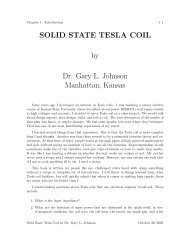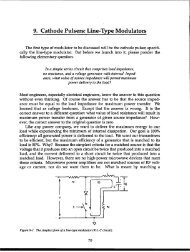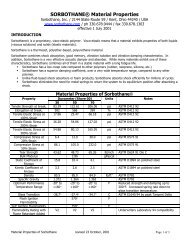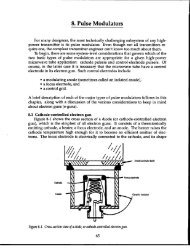3.6M north10.pdf - Dean-O's Toy Box
3.6M north10.pdf - Dean-O's Toy Box
3.6M north10.pdf - Dean-O's Toy Box
You also want an ePaper? Increase the reach of your titles
YUMPU automatically turns print PDFs into web optimized ePapers that Google loves.
198 High-Power Microwave-Tube Transmitters<br />
Table 10-1. Operating parameters of 18-MW hard-tube modulator shown in Fig. 10-37<br />
Parameter<br />
Value<br />
Pulse voltage to klystron<br />
130 kV<br />
Pulse output current<br />
140A<br />
Peak-power output<br />
18MW<br />
Pulse duration<br />
3-28 us<br />
Burst mode<br />
32 pulses, max.,<br />
4-@ duration,<br />
7-28-Ks spacing<br />
Pulse-Dair mode<br />
10-LLSduration,<br />
13-”1.lspacing<br />
-,—– .,---,<br />
t-me rfme<br />
1.2@<br />
Duty ~Iabd)t’ ‘-n”<br />
0.03, max.<br />
Pulse-lup- ‘-- I-:-pie lpi O.l”/O (dl’w;ngRF) Jill<br />
Pulse-to-pulse<br />
.- ..-”:-x----- Ian >1<br />
Vdrlttllw[IS I USE.<br />
I<br />
I<br />
at the side-to-side endings of the parallel plates. Merely extending the dielectric<br />
material between the plates far beyond the ends of the plates did nothing to<br />
prevent corona discharges, which rather quickly punctured the dielectric material.<br />
Reducing fall-time di/di did not completely cure EOPSTA, however. Other<br />
effects were also at work. The temperature of the control grids, which were<br />
subject to power dissipation throughout each output pulse, reached transient<br />
maxima at the end of each pulse. This made them more likely to emit secondary<br />
electrons and less likely to establish zero-current conditions within the tubes<br />
when their voltages were brought to the negative voltage that should have been<br />
adequate for current cutoff. Experiments were performed where grid drive voltage<br />
and conduction-anode-voltage dmp were interchanged between so-called<br />
hard-drive and soft-drive conditions. Unfortunately reducing intrapulse grid<br />
drive voltage and increasing anode supply voltage to compensate for it produced<br />
a statistically insignificant difference in spark-down rate. The only thing that<br />
really worked was operating the circuit at lower voltage and lower power.<br />
The suggestion that the problem may have been caused by the tubes’ “hot<br />
grids” gave rise to an experiment that replaced the eight triodes with eight tetrodes<br />
of roughly comparable capability (type 4CW250,000). It turned out, however,<br />
that “hot screens” produced much the same effect as “hot grids.” VMually<br />
no improvement was noted.<br />
This modulator experiment did, however, lead to a successful 60-MW pulse<br />
modulator, which used six parallel-connected WL-8461 triodes that pulsed a 20-<br />
MW-peak-power UHF klystron in the transmitter of an instrumentation radar.<br />
The system worked well for many years.<br />
10.7.2 An 18-MW hard-tube modulator using the L-5097 beam-switch tube<br />
Waveform versatility and both pulse-top and pulse-to-pulse precision are the<br />
salient features of the hard-tube modulator shown in Fig. 10-37. A broad-band<br />
high-performance S-band klystron, the VKS-8250, is directly cathode pulsed by a<br />
group of three paralleled L-5097 BSTS. The pulsed cathode voltage, which is 130<br />
kV, is driven by a power supply with maximum dc output of 160 kV. The total







